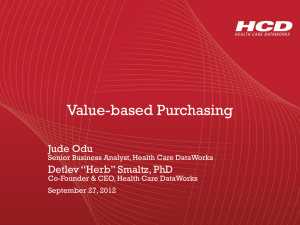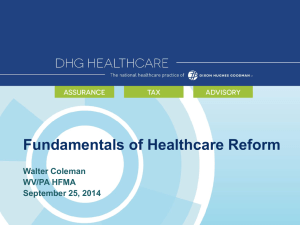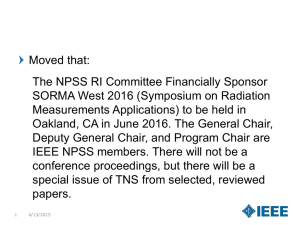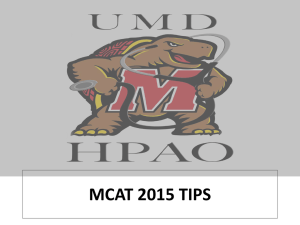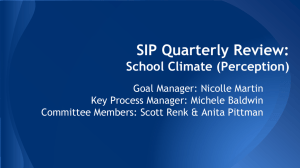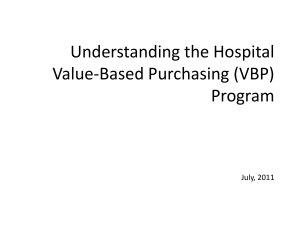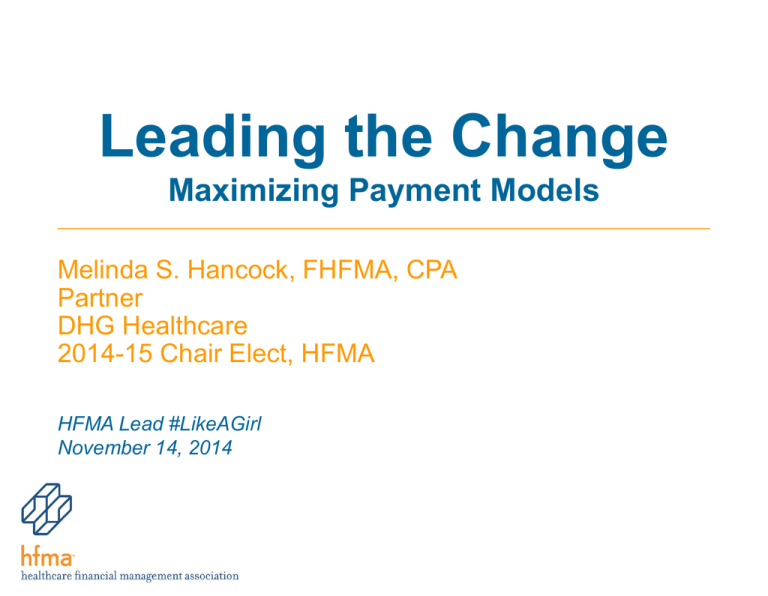
Leading the Change
Maximizing Payment Models
Melinda S. Hancock, FHFMA, CPA
Partner
DHG Healthcare
2014-15 Chair Elect, HFMA
HFMA Lead #LikeAGirl
November 14, 2014
"If your actions inspire others to dream more,
learn more, do more, and become more, you are
a leader.” – John Quincy Adams
ACA Gains through 2019
Amounts in Billions
Source:CBO and Joint Committee on Taxation, 2010 Projection
Revenue
Industry Tipping Point
Time
•
•
•
•
How do local market conditions impact timing considerations?
Can market-changing events create an urgent paradigm shift?
What is my step-change business model risk?
Do I have the financial tools to adequately analyze relevant states?
4
Payment
Modelof
& Increasing
Acceptance
Hierarchy
Risk andRisk
Payment
Models
5
Alignment of Strategy and Metrics
Questions to Ask
•
How many metrics am I tracking?
•
How many metrics are duplicated? Do they have the
same numerator and denominator? Source?
•
Are they aligned with our results and strategic goals?
•
What contracts are coming up for renewal that should
have new metrics or should be at risk (mgd care,
medical directorships, PMAs, etc.)
•
What are we focused on?
Reform Timeline
Value Based Purchasing
VBP Shifting of Domain Weights
FY 2013
FY 2014
• Core Measures
• Patient Experience
FY 2015
FY 2016
• Outcomes
• Efficiency (MSPB)
New NQS Based Domains for FY 2017
Clinical Care Process = 5%
HCAHPS = 25%
Clinical Care Outcomes = 25%
Safety = 20%
MSPB = 25%
10
VBP – FY13 Domain Weights
Performance Period: July 1, 2011 – March 31, 2012
Reimbursement Period: October 1, 2012 – September 30, 2013
Core Measures = 70%
VBP – FY14 Domain Weights
Performance Period: April 1, 2012 – December 31, 2012
Reimbursement Period: October 1, 2013 – September 30, 2014
Outcomes = 25%
Core Measures = 45%
VBP – FY15 Domain Weights
Performance Period: January 1, 2013 – December 31, 2013
Reimbursement Period: October 1, 2014 – September 30, 2015
HCAHPS = 30%
Outcomes = 30%
Core Measures = 20%
MSPB = 20%
One Measure!!
VBP – FY16 Domain Weights
Performance Period: January 1, 2014 – December 31, 2014
Reimbursement Period: October 1, 2015 – September 30, 2016
Core Measures = 10%
HCAHPS = 25%
MSPB = 25%
Outcomes = 40%
VBP – FY16 Domain Weights
Performance Period: January 1, 2014 – December 31, 2014
Reimbursement Period: October 1, 2015 – September 30, 2016
Clinical Care - Process = 5%
HCAHPS = 25%
Clinical Care Outcomes = 25%
Safety = 20%
MSPB = 25%
15
Value Based Purchasing
•
Outcomes = Income
•
Mandatory Pay for Performance Program
– 3,500 hospitals are included in this program across the country
•
Reimbursement Determine Two Ways:
– Achievement
How we compare to National Top Decile (350 Hospitals)
– Improvement
How we measure against ourselves
Did we do better than a previously measured baseline period
Value Based Purchasing
•
•
Percent of Medicare Reimbursement at Risk
•
FY 2013 – 1.00%
•
FY 2014 – 1.25%
•
FY 2015 – 1.50%
•
FY 2016 – 1.75%
•
FY 2017 – 2.00%
•
FY 2018 – 2.00%
•
FY 2019 – 2.00%
FY 20xx – refers to the Federal Fiscal Year (Oct. 1 – Sep. 30) when DRG
payments will be affected
VBP FY 2016 – New Measures
•
Patient Experience
– No Change – Same HCAHPS Measures
•
Core Measures
– 5 Dropped; 1 New
•
Outcomes
– 3 New Measures
•
Efficiency
– No Change
VBP – FY 2016 – Patient Experience
•
HCAHPS
– Hospital Consumer Assessment of Healthcare Providers Survey
– An engagement survey CMS has mandated each hospital give to every
discharged inpatient
– Consists of 27 questions that lead to the 8 categories assessed for VBP
– Patients score each question on scale of 4
– For answers to count, patients must give hospitals a score of 4 or “Always”
VBP FY 2016 – Patient Experience
•
Communication with Nurses
•
Communication with Doctors
•
Responsiveness of Hospital Staff
•
Pain Management
•
Communication about Medicines
•
Cleanliness and Quietness of Hospital
•
Discharge Information
•
Overall Rating of Hospital
VBP FY 2015 – Core Measures
•
•
•
•
•
•
AMI-7a
AMI-8a
HF-1
PN-3b
PN-6
SCIP-Inf-1
•
•
•
•
•
•
SCIP-Inf-2
SCIP-Inf-3
SCIP-Inf-4
SCIP-Inf-9
SCIP-Card-2
SCIP-VTE-2
VBP FY 2016 – Core Measures
• AMI-7a
• SCIP-Inf-9
• PN-6
• SCIP-Card-2
• SCIP-Inf-2
• SCIP-VTE-2
• SCIP-Inf-3
• IMM-2
Note: IMM-2 Performance Period is only 6 MONTHS (Two 3 Month
Periods)January 1, 2014 – March 31, 2014 AND October 1, 2014 –
December 31, 2014
VBP FY 2016 – Core Measures
Measure ID
Benchmark
AMI-7a
100%
IMM-2
98.875%
PN-6
100%
SCIP-Inf-2
100%
SCIP-Inf-3
100%
SCIP-Inf-9
100%
SCIP-Card-2
100%
SCIP-VTE-2
100%
VBP FY 2016 – Core Measures
• AMI-7a
• SCIP-Inf-9
• PN-6
• SCIP-Card-2
• SCIP-Inf-2
• SCIP-VTE-2
• SCIP-Inf-3
• IMM-2
VBP FY 2017 – Clinical Care: Process
• AMI-7a
• IMM-2
• PC-01
PC-01 = Elective Delivery Prior to 39 Completed Weeks
Gestation
VBP FY 2015 – Outcomes
•
30 Day Mortality – AMI
•
30 Day Mortality – HF
•
30 Day Mortality – PN
•
AHRQ – PSI-90
•
CLABSI
VBP FY 2016 – Outcomes
•
30 Day Mortality – AMI
•
30 Day Mortality – HF
•
30 Day Mortality – PN
•
AHRQ – PSI-90
•
CLABSI
•
CAUTI
•
SSI – Colon
•
SSI – Abdominal Hysterectomy
VBP FY 2016 – Outcomes
Measure ID
Benchmark
CAUTI
0.000
CLABSI
0.000
Surgical Site Infection
Colon
0.000
Abdominal
Hysterectomy
0.000
VBP FY 2016 – Outcomes
Outcomes
• 30 Day Mortality – AMI
• 30 Day Mortality – HF
• 30 Day Mortality – PN
• AHRQ – PSI-90
• CLABSI
• CAUTI
• SSI-Colon
• SSI-Abdominal Hyster.
VBP FY 2017 – Clinical Care and
Safety
Clinical Care- Outcomes
Safety
• 30 Day Mortality – AMI
• 30 Day Mortality – HF
• 30 Day Mortality – PN
• AHRQ – PSI-90
• CLABSI
• CAUTI
• SSI-Colon
• SSI-Abdominal Hyster.
• MRSA
• C. Diff
Reform Timeline
Outcomes – 30 Day Mortality
•
•
Currently in 3 Performance Periods
–
FY 2016 ended June 30, 2014
–
FY 2019 began July 1, 2014
30 Day Mortality Measures
– Assess deaths: AMI, HF, and PN that occur within 30 days after
admission; which, depending on the length of stay, may occur postdischarge….
CMS 30 Day Risk-Standardized Mortality Rate
Calculation
=
Facility Predicted Deaths
X
Facility Expected Deaths
Measure (AMI,
HF, PN) National
Crude Rate
VBP FY 2016 - Efficiency
Medicare Spend Per Beneficiary (MSPB)
•
Captures total Medicare Spending Per Beneficiary relative to a hospital stay,
bundling hospital sources (Part A) with post acute care (Part B)
– Bundles the cost of care delivered to a beneficiary for an episode across
the continuum of care:
3 Days Prior
Hospital Inpatient Stay
30 Days post Discharge
VBP: MSPB
Sample
US
VBP: MSPB
36
•
PROPOSED MSPB Measures
Additional Efficiency Measures proposed to be added
Medical
Surgical
Kidney/Urinary Tract
Infection
Hip replacement/revision
Cellulitis
Knee replacement/revision
Gastrointestinal
hemorrhage
Lumbar spine
fusion/refusion
•
Risk Adjusted similarly to MSPB
•
Proposed to facilitate alignment with the Physician Value Based Payment
•
Modifier program
Includes Part A and B and 3 days prior to admission and 30 days post discharge
SOURCE: May 1, 2014 Federal Register
37
CGH
System
VBP FY'13
FY'15 TOTAL PERFORMANCE
Earned Back
Unearned
Available $$
$4,925,357
$288,853
$6,187,541
$540,406
$11,112,898
$829,259
$4,925,357
% Earned
34.83%
44.32%
Breakeven Point: $5,301,360
Breakeven Point: $451,333
$288,853
$0
$0
$829,259
$11,112,898
Chesapeake
OverallGeneral
Performance
Performance
System was penalized $376,003 in FY’15 VBP Program
•
Must acknowledge the amount UNEARNED
•
Of the programs dollars made available:
– System did not capitalize on $6,187,541
Facility
Earned Back
$381,643
Core Measures
Unearned
Measure Value
$218,077
$599,720
% Earned
63.64%
Breakeven Point: $232,525
Facility
$539,763
$599,720
Earned Back
$278,896
$278,896
HCAHPS
Unearned
Measure Value
$620,704
$899,600
% Earned
60.00%
Breakeven Point: $348,788
$381,643
$0
Facility
Earned Back
$539,763
Outcomes
Unearned
Measure Value
$359,837
$899,600
% Earned
31.00%
$0
Facility
Earned Back
$59,974
Breakeven Point: $348,788
$899,600
Efficiency
Unearned
Measure Value
$539,746
$599,720
% Earned
10.00%
Breakeven Point: $232,535
$59,974
$0
$899,600
$0
$599,720
Facility
Facility A
Bonus / (Penalty)
$97,593
Total Score
42.03
State Average
41.81933117
National Average
41.70169535
National Δ
0.325577377
Measure
Score
Amount Earned
by Measure
Amount
Unearned by
Measure
% of Measure
Earned
Core Measures
AMI-8a
SCIP-Inf-1
SCIP-Inf-2
SCIP-Inf-3
SCIP-Inf-4
SCIP-Inf-9
HF-1
PN-3b
PN-6
SCIP-Card-2
SCIP-VTE-2
Core Measures TOTAL
6
9
7
5
9
5
8
5
8
3
5
$
$
$
$
$
$
$
$
$
$
$
$
32,712
49,068
38,164
27,260
49,068
27,260
43,616
27,260
43,616
16,356
27,260
381,643
$
$
$
$
$
$
$
$
$
$
$
$
21,808
5,452
16,356
27,260
5,452
27,260
10,904
27,260
10,904
38,164
27,260
218,077
60.00%
90.00%
70.00%
50.00%
90.00%
50.00%
80.00%
50.00%
80.00%
30.00%
50.00%
63.64%
Comm. w/ Nurses
Comm. w/ Doctors
Resp. of Hosp. Staff
Pain Management
Comm. Re: Medicines
Clealiness & Quietness
Discharge Information
Overall Rating
2
1
2
2
1
2
3
1
$
$
$
$
$
$
$
$
17,994
8,998
17,994
17,994
8,998
17,994
26,990
8,998
$
$
$
$
$
$
$
$
71,966
80,962
71,966
71,966
80,962
71,966
62,970
80,962
20.00%
10.00%
20.00%
20.00%
10.00%
20.00%
30.00%
10.00%
Consistency Score
HCAHPS TOTAL
17
$
$
152,933
278,896
$
$
26,987
620,704
85.00%
31.00%
AMI
HF
PN
AHRQ PSI-90
CLABSI
Outcomes TOTAL
10
3
8
9
0
$
$
$
$
$
$
179,920
53,980
143,934
161,928
0
539,763
$
$
$
$
$
$
(0)
125,940
35,986
17,992
179,920
359,837
100.00%
30.00%
80.00%
90.00%
0.00%
60.00%
MSPB
1
$
$
59,974
59,974
$
$
539,746
539,746
10.00%
Efficiency TOTAL
Facility TOTAL
$
1,260,277
$
1,738,363
42.03%
HCAHPS
Outcomes
Efficiency
Pain Management
Comm. Re: Medicines
Clealiness & Quietness
Discharge Information
Overall Rating
2
1
2
3
1
$
$
$
$
$
17,994
8,998
17,994
26,990
8,998
$
$
$
$
$
71,966
80,962
71,966
62,970
80,962
20.00%
10.00%
20.00%
30.00%
10.00%
Consistency Score
HCAHPS TOTAL
17
$
$
152,933
278,896
$
$
26,987
620,704
85.00%
31.00%
AMI
HF
PN
AHRQ PSI-90
CLABSI
Outcomes TOTAL
10
3
8
9
0
$
$
$
$
$
$
179,920
53,980
143,934
161,928
0
539,763
$
$
$
$
$
$
(0)
125,940
35,986
17,992
179,920
359,837
100.00%
30.00%
80.00%
90.00%
0.00%
60.00%
MSPB
1
$
$
59,974
59,974
$
$
539,746
539,746
10.00%
1,738,363
42.03%
Drilldown on Outcomes…
Outcomes
Efficiency
Efficiency TOTAL
Variation within the Domain:
Facility TOTAL
$
1,260,277
$
Maxed out on AMI Mortality and then got a 0 on CLABSI
Opportunities – VBP: Outcomes
1
30 Day Mortality Rate - PN
∆
FY14
87.40%
Performance
-2.18%
89.58%
Baseline
-0.78%
88.18%
Threshold
-2.81%
90.21%
Benchmark
0
Score
Improvement
+1%
+1.5%
+2.5%
+3.5%
+4.5%
+5.5%
+6.5%
+7.5%
+8.5%
Dollar Value
13,209
$
52,836
$
105,673
$
132,091
$
132,091
$
132,091
$
132,091
$
132,091
$
132,091
$
Score
1
4
8
10
10
10
10
10
10
2
30 Day Mortality Rate - AMI
∆
FY14
83.81%
Performance
-0.95%
84.76%
Baseline
-0.96%
84.77%
Threshold
-2.92%
86.73%
Benchmark
0
Score
Improvement
+1%
+1.5%
+2.5%
+3.5%
+4.5%
+5.5%
+6.5%
+7.5%
+8.5%
Dollar Value
13,209
$
39,627
$
105,673
$
132,091
$
132,091
$
132,091
$
132,091
$
132,091
$
132,091
$
Score
1
3
8
10
10
10
10
10
10
3
30 Day Mortality Rate - HF
∆
FY14
85.21%
Performance
-3.73%
88.94%
Baseline
-3.40%
88.61%
Threshold
-5.21%
90.42%
Benchmark
0
Score
Improvement
+1%
+1.5%
+2.5%
+3.5%
+4.5%
+5.5%
+6.5%
+7.5%
+8.5%
Dollar Value
$
$
$
13,209
$
79,254
$
132,091
$
132,091
$
132,091
$
132,091
$
Score
0
0
0
1
6
10
10
10
10
Top 50th = Δ1 Patient
Top 50th = Δ1 Patient Top 50th = Δ8 Patients
Top 10th = Δ3 Patient
Top 10th = Δ3 Patient Top 10th = Δ11 Patients
42
VBP – CMS Proposed Future
Measures
• FY 2018 Program (Performance Period: CY 2016)
– Patient Experience: Care Transition
• FY 2019 Program (Performance Period: CY 2017)
– Surgical Complication: Total Hip and Total Knee
Arthroplasty
FY 19 New Measure
•
Added THA/TKA for 30 month performance period.
– January 1, 2015-June 30, 2017
– Baseline of July 1, 2010-June 30, 2013
•
Risk standardized measure for complications after Total Hips and Knees
surgeries for up to 90 days post surgery
– One of eight complications: AMI, pneumonia, sepsis, SSI, PE, death,
mechanical complication or periprosthetic joint infection/wound infection.
– Each has a defined time frame
– Each is a ‘Yes’ or ‘No
– Risk adjusted for patient age, sex and comorbidities
SOURCE: August 2014 Proposed Rules Federal Register
44
Readmission Reduction Program
Reform Timeline
•
Readmission Reduction Program
9% of Current and Future Medicare Reimbursement at Risk
– 3% penalty of Medicare Reimbursement at risk each program year
– Measured Populations 30 days from DISCHARGE
•
AMI, HF, PN, COPD, THA & TKA
•
August 2014: CABG Added to FY 2017
•
Performance Periods: 3 Year Rolling Program
– FY’15: July 1, 2010 – June 30, 2013 – 3%
– FY’16: July 1, 2011 – June 30, 2014 – 3%
– FY’17: July 1, 2012 – June 30, 2015 – 3%
– FY’18: July 1, 2013 – June 30, 2016 – 3%
– FY’19: July 1, 2014 – June 30, 2017 – 3%
Currently participating in 3
performance periods
simultaneously
How are Readmissions Measured?
•
Scoring Index based at 1.0
•
Calculate Excess Readmission Ratio
Facility Predicted Value
Facility Expected Value
•
Excess Readmission Ratio > 1 = BAD
•
Excess Readmission Ratio < 1 = GOOD
Wisconsin RRP By Facility: FY 13- FY 15
RRP %
1.80%
1.60%
1.40%
1.20%
1.00%
0.80%
0.60%
0.40%
0.20%
0.00%
FY 13
FY 14
FY 15
Hospital Acquired Conditions
Reform Timeline
Hospital Acquired Conditions (1% at
Risk*)
• 12 Hospital Acquired Conditions Identified
– Divided in to 2 Domains
• If a hospital is in the BOTTOM QUARTILE (worst
performing 25% in the country), it will be penalized a
FULL 1% of Medicare Reimbursement
• Penalties will begin FY’15 (beginning October 1, 2014)
*1% After DSH, Uncompensated Care, and IME
Penalties & Your DRG Payment
SAMPL IPPS Reimbursement Letter
PPS EFFECTIVE 10/1/2014
OPERATING INFORMATION
Federal National Standardized Labor Rate
Wage Index
Labor Rate x Wage Index
Federal National Standardized Non-Labor Rate
PPS Blended Rate
FY 2015 Hospital Readmissions Reduction (HRR) Adjustment Factor
FY 2015 Value-Based Purchasing (VBP) Adjustment Factor
DRG Weight
Facility CMI
0.9994
0.994348
1.00
1.54
3,329.57
0.8994
2,994.62
2,040.71
5,035.33
5,032.30
5,003.86
($3.02) RRP Reduction
($28.44) VBP Reduction
($31.46) Per DRG Reduction
($31.46) x 1.54
Disproportionate Share Adjustment (Operating) (Empirically Justified Amount 25%)
Disproportionate Share Adjustment (Operating) (Uncompensated Care Amount)
Fully Loaded Operating Rate adjusted for CMI
FY 2015 Hospital Acquired Condition (HAC) Adjustment Factor
0.0691
0.99
($48.45)
VBP & RRP Per
DRG Red. CMI Adj
($83.47)
HAC Per DRG
CMI Adjusted
($131.92)
Total Per DRG
Reduction
0.02 5,090.43
507.71 5,598.14
8,346.97
8,263.50
Hospital Acquired Conditions: FY’15
First Domain: PSIs
Performance Period: 7/1/11-6/30/13
Second Domain: CDC
Performance Period: CY 2012 & 2013
Pressure Ulcer Rate
CLABSI
Foreign Object Left in Body
CAUTI
Iatrogenic Pneumothorax Rate
Postoperative Physiologic and
Metabolic Derangement Rate
Postoperative Pulmonary Embolism and
Deep Vein Thrombosis Rate
Accidental Puncture and Laceration
Rate
HAC Domain Weightings: FY’15
DOMAIN 1: 35%
Pressure Ulcer Rate: 8.33%
DOMAIN 2: 65%
CLABSI: 32.5%
Foreign Object Left
In Body: 8.33%
CAUTI: 32.5%
Hospital Acquired Conditions: FY
2016
First Domain: PSIs
25%
Second Domain: CDC
75%
Pressure Ulcer Rate
CLABSI
Foreign Object Left in Body
CAUTI
Iatrogenic Pneumothorax Rate
SSI Following Colon Surgery (FY 2016)
Postoperative Physiologic and
Metabolic Derangement Rate
SSI Following Abdominal Hysterectomy
(FY 2016)
Postoperative Pulmonary Embolism and
Deep Vein Thrombosis Rate
Accidental Puncture and Laceration
Rate
HAC Domain Weightings: FY’16
DOMAIN 1: 25%
DOMAIN 2: 75%
Pressure Ulcer Rate: 5.83%
CLABSI: 32.5%
SSI: 32.5%
CAUTI: 32.5%
57
Hospital Acquired Conditions: FY
2017
First Domain: PSIs
Second Domain: CDC
Pressure Ulcer Rate
CLABSI
Foreign Object Left in Body
CAUTI
Iatrogenic Pneumothorax Rate
SSI Following Colon Surgery (FY 2016)
Postoperative Physiologic and
Metabolic Derangement Rate
SSI Following Abdominal Hysterectomy
(FY 2016)
Postoperative Pulmonary Embolism and Methicillin-Resistant Staphylococcus
Deep Vein Thrombosis Rate
Aureus (MRSA) Bacteremia (FY 2017)
Accidental Puncture and Laceration
Rate
Clostridium Difficile (FY 2017)
Dollars At Risk
VBP FY 2016 – Sample Current $$ at
Risk
VBP FY 2016
Domain
Weight
At Risk
Medicare Spend Per Beneficiary
25%
$ 745,471
Outcomes
40%
$ 1,192,753
Patient Experience
25%
$ 745,471
Core Measures
10%
$ 298,188
TOTAL
100%
On the Table
$
1,562,507
$
2,500,011
$
1,562,507
$
625,003
$ 2,981,883 $
6,250,028
VBP – Sample Total Current $$ at Risk
VBP Current Dollars At Risk (Active Performance Periods)
On the Table
At Risk
Weight
Domain
FY 2016
1,562,507
$ 745,471 $
25%
Medicare Spend Per Beneficiary
2,500,011
$ 1,192,753 $
40%
Outcomes
1,562,507
$ 745,471 $
25%
Patient Experience
625,003
$ 298,188 $
10%
Core Measures
FY 2017
1,785,722
$ 851,967 $
25%
Outcomes - 30 Day Mortality
267,858
3.75% $ 127,795 $
Outcomes - AHRQ
FY 2018**
1,785,722
$ 851,967 $
25%
Outcomes - 30 Day Mortality
267,858
3.75% $ 127,795 $
Outcomes - AHRQ
FY 2019**
1,785,722
$ 851,967 $
25%
Outcomes - 30 Day Mortality
TOTAL
$ 5,793,374 $
12,142,911
All Reform – Sample Total Current $$
at Risk
All Active Mandatory Reform
Domain
On the Table
FY 2016
Value Based Purchasing
Readmissions
Hospital Acquired Conditions
FY 2017
Value Based Purchasing
Readmissions
Hospital Acquired Conditions
FY 2018**
Value Based Purchasing
Readmissions
FY 2019**
Value Based Purchasing**
Readmissions
TOTAL
$
6,250,028
COMPLETE
$
1,703,933
$
$
$
2,053,581
5,111,800
1,703,933
$
$
2,053,581
5,111,800
$
$
1,785,722
5,111,800
$
30,886,178
VBP – CMS Proposed Future
Measures
• FY 2018 Program (Performance Period: CY 2016)
– Patient Experience: Care Transition
• FY 2019 Program (Performance Period: CY 2017)
– Surgical Complication: Total Hip and Total Knee
Arthroplasty
FY 19 New Measure
•
•
Added THA/TKA for 30 month performance period.
–
January 1, 2015-June 30, 2017
–
Baseline of July 1, 2010-June 30, 2013
Risk standardized measure for complications after Total Hips and Knees surgeries for up to 90 days post surgery
–
One of eight complications: AMI, pneumonia, sepsis, SSI, PE, death, mechanical complication or periprosthetic joint infection/wound infection.
–
Each has a defined time frame
–
Each is a ‘Yes’ or ‘No
–
Risk adjusted for patient age, sex and comorbidities
SOURCE: August 2014 Proposed Rules Federal Register
64
Bundled Payments
Description of Models 1 - 4
Models 2 and 3 are the
most popular by farretrospective vs
prospective models
that include the post
acute care components
66
Bundled Payments
Model 1 and 4
Model 1 is Retrospective and is all DRGs
Model 4 is Prospective
Acute
Readmission
Home
LTACH/SNF/
IRF
HH
67
Bundled Payments
Model 2
Model 2 is Retrospective
For 30-60-90 days
Acute
Readmission
Home
LTACH/SNF/
IRF
HH
68
Bundled Payments
Model 3
Model 3 is Retrospective
For 30-60-90 days
Acute
Readmission
Home
LTACH/SNF/
IRF
HH
69
The Episodes
•
CMS created 48 Episodes, each with up to 15 individual MS-DRG codes
•
We categorized Episodes into 9 Service Lines; illustrative purposes only
•
Model 2, 3, or 4 applicants may select 1-48 Episodes for testing
Spine (5)
Cardiac
Services (12)
Vascular
Services (3)
Orthopedics
(10)
Neurology (2)
Oncology /
Hematology (1)
General
Surgery (2)
General
Medicine /
Internal
Medicine (10)
Pulmonology
(3)
http://innovation.cms.gov/initiati
ves/bundled-payments/
70
Advantages of Participation
•
Improved quality of care for patients
– Reduced complications, readmissions, and cost
•
Improved ability to work with hospitals, physicians, nursing homes, home health,
rehab centers, and other providers to improve overall care quality and service
•
Potential competitive advantage within market with physicians and post-acute care
•
Opportunity to receive payment aligned with these goals and based on outcomes
71
Where are the Bundled Payments?
MEDICARE: Cohort 1
COMMERCIAL as of July 2014
http://innovation.cms.gov/initiatives/bundled-payments/
72
Early Results of BPCI Cohort 2
• Tremendous increase in the
number of applications in the
most recent open enrollment
in April 2014: Nearly Triple!
• Models 2,3,4 were open for
enrollment
• Currently in the Phase 1
period which is the non risk,
decision making period.
Phase 2 is when the Episode
Initiator starts to accept risk
Changes In the Cohort 2 Timeline:
7/31/14
Event
Original Date
Revised Date*
Historical Claims &
Target Pricing
Late Summer
2014
November 2014
Go/No Go Decision November 1, 2014
to Participate
January 11, 2015
Go Live with Risk
April 1, 2015
January 1, 2015
Other significant changes:
ADDITION OF EPISODES: You can now add episodes in
July 2015 and October 2015: only 1 episode is required
for April 1, 2015. Phase 1 ends in October 2015
B-CARE: B-CARE quality data wont be collected until
Spring 2015
Option for Delayed Reconciliation: Will offer a 4
quarter timeline for reconciliation.
* Revised again in October 2014
Readiness: Risk Capability
•
What are your data analytics and capabilities and
ability to operationalize your quality data
•
What is the maturity of your physician network and
post acute care network? What do you know about
each? What don’t you know?
•
How are you doing on the VBP and RRP that are
building blocks for this? How are you going to
manage the gain sharing
•
What quality metrics are you tracking and need to
improve that can be built into this program
•
What internal cost sharing could you roll out with
75
this?
Strategic Planning: How does it all tie
in?
System/Facility Strategic Plan
Clinically Integrated Networks/Post Acute
Care Networks
Payment Models
MSSP/BPCI/VBP/RRP/HAC
Managed Care/Direct to
Employer Opportunities
76
DRG 470 Total Joint Replacement w/out
CC
Model 2
$3,207
MD
+
DRG Inpatient and PACS Fee for Service
Model
+
+
$10,12
$8,965
$616
9
•
•
•
•
Home Health
SNF
IRF
Outpt. Rehab
=
$22,927
x 98%
Home
$22,468
Readmission
Episodic period for model 2: 3 days prior to admission to 90 days post discharge from hospital
$22,468
Bundled Episodic Model
Note: any CMI aggregate charges lower than $22,468 can be shared with providers via gain
sharing model
Gain Sharing Model
Shared Reward
($$)
Physician
Setting
Surgeon
Hospital
Anesthesiologist
SNF
Hospitalist
Home Health
Outpatient Physician
78
Bundled Payment Episode Pricing and Gain Sharing
2008-2009
Historical Cost
Per Episode
$12,500
2013
Update factor
Target Price
$13,647
Quality
Metrics
For illustration:
3% inflation/yr
Discount = 3%
Settlement
(Per Case)
$247
BPLN
Episode
Definitions
Risk
Adjustment
Physicians
(35%)
$86
Actual FFS Cost
during
Performance
Period
$13,400
Quality
Metrics
Quality
Metrics
Environment of
Care - Hospital
(40%)
$99
Environment of
Care - Post-acute
(25%)
$62
79
BPCI Multiple Bonus Payments:
Physicians
•
2 opportunities for Physicians to be awarded Bonuses
1.
Internal Cost Savings Pool
2.
Bundled Payment Savings Pool
•
Both have required Quality Metrics and Cost Savings to be met
•
Cost Savings MUST be directly attributed to Quality Improvement and Care
Redesign
80
Outpatient Bundling…coming soon?
In February 2014, CMMI issued a Request for Information on a new bundled
payment program to expand to outpatient.
•
•
•
Focus is Specialty Physicians and on
(1) Procedures and (2) complex chronic care
Highlighted colonoscopy, cataract surgery, & radiation therapy for
procedural options.
Regarding the chronic care, “CMS is considering development of a model
that would incentivize specialists to more efficiently manage the care
provided to beneficiaries with complex or chronic medical conditions over
the period of time that corresponds to the specialty practitioner’s long term
involvement with managing the beneficiary’s care.”
Was seeking responses until March 13
•
Outpatient Bundling
Referred to by CMS as: “Comprehensive Ambulatory Payment Classification
(APC)”
•
Finalized in the CY 2014 OPPS/ASC Final Rule
•
Affect payments to 4,000 hospitals and 5,300 ASC’s
•
Delayed implementation to January 1, 2015 instead of the traditional outpatient
October 1 implementation date
– Extra time allowed the Agency, hospitals, and physicians more time to evaluate
and comment on the policy
Outpatient Bundling –
Comprehensive APC’s
• Single Medicare payment rather than individual APC
payments throughout the episode
• 25 Bundled Outpatient Procedures
• Proposed Payment could include all hospital services
reported on the claim covered under Medicare Part B
for up to a proposed 6 Month Period
– Few exceptions resulting in a single beneficiary
copayment per claim
Outpatient Bundling – Proposed
Procedures
No.
Clinical
Family
Proposed CY
2015 APC
1
2
3
4
5
6
7
8
9
10
11
12
13
14
15
16
17
18
19
20
21
22
23
24
25
26
27
28
AICDP
AICDP
AICDP
AICDP
AICDP
BREAS
CATHX
CATHX
ENTXX
EPHYS
EPHYS
EPHYS
EYEXX
EYEXX
GIXXX
NSTIM
NSTIM
NSTIM
ORTHO
PUMPS
RADTX
UROGN
UROGN
UROGN
VASCX
VASCX
VASCX
VASCX
0090
0089
0655
0107
0108
0648
0427
0652
0259
0084
0085
0086
0293
0351
0384
0061
0039
0318
0425
0227
0067
0202
0385
0386
0083
0229
0319
0622
APC Title
Level II Pacemaker and Similar Procedures
Level III Pacemaker and Similar Procedures
Level IV Pacemaker and Similar Procedures
Level I ICD and Similar Procedures
Level II ICD and Similar Procedures
Level IV Breast and Skin Surgery
Level II Tube or Catheter Changes or Repositioning
Insertion of Intraperitoneal and Pleural Catheters
Level VII ENT Procedures
Level I Eletrophysiologic Procedures
Level II Eletrophysiologic Procedures
Level III Eletrophysiologic Procedures
Level IV Intraocular Procedures
Level V Intraocular Procedures
GI Procedures with Stents
Level II Neurostimulator & Related Procedures
Level III Neurostimulator & Related Procedures
Level IV Neurostimulator & Related Procedures
Level V Musculoskeletal Procedures Except Hand and Foot
Implantation of Drug Infusion Device
Single Session Cranial Stereotactic Radiosurgery
Level V Female Reproductive Procedures
Level I Urogenital Procedures
Level II Urogenital Procedures
Level I Endovascular Procedures
Level II Endovascular Procedures
Level III Endovascular Procedures
Level II Vascular Access Procedures
Proposed CY
2015 APC
Geometric
Mean Cost
$
6,961.45
$
9,923.94
$
17,313.08
$
24,167.80
$
32,085.90
$
7,674.20
$
1,522.15
$
2,764.85
$
31,273.34
$
922.84
$
4,807.69
$
14,835.04
$
9,049.66
$
21,056.40
$
3,307.90
$
5,582.10
$
17,697.46
$
27,283.10
$
10,846.49
$
16,419.95
$
10,227.12
$
4,571.06
$
8,019.38
$
14,549.04
$
4,537.95
$
9,997.53
$
15,452.77
$
2,635.35
Thank you!
Contact Information:
Melinda Hancock
Melinda.Hancock@dhgllp.com
(804) 474-1249
Affinity Groups
• Current
• Newly Formed and Actively
Meeting
– Large System CFO
Council
– Health Care Economics
Professional Council
– Large System Revenue
Cycle Council
– Physician Group
Practice Executive
Council
– Strategic CFO Council
• Being Formed
– Strategy Executive
Council
– CMMI Bundled for Care
Improvement Council
– Academic Medical
Center CFO Council
– Payer Focused Affinity
Group
86
Master Level Seminars
•
•
•
Chicago, IL | Dec. 8-10, 2014
–
Beyond Big Data: Developing a Business Intelligence and Analytics Practice
–
Population Health Management and the Next Generation of Clinical Integration
Washington, DC | Feb. 18-20, 2015
–
Population Health Management and the Next Generation of Clinical Integration
–
Transparency, Metrics, and Communication: Proven Practices for Revenue Cycle Strategies
Seattle, WA | March 25-27, 2015
–
Beyond Big Data: Developing a Business Intelligence and Analytics Practice
–
Transparency, Metrics, and Communication: Proven Practices for Revenue Cycle Strategies
87
Improve the Billing and Payment
Experience for Patients
hfma.org/dollars
88
Price Transparency Task Force
89
Enhance Price Transparency
• Clarifies basic definitions
that are often misused
• Sets forth guiding
principles
• Establishes roles for
payers, providers, others
• Reflects consensus of
key stakeholders
hfma.org/dollars
90
Demystify Price Information for
Consumers
• Describes how to request price
estimates, step by step
• Clarifies what estimates may or
may not include
• Explains in-network and
out-of-network care
• Defines key terms
• Available for posting on your
website at no charge
• Hardcopies available for purchase
in bulk at a nominal price through
AHA’s online store
hfma.org/transparency
ahaonlinestore.org
91
Best Practices Address Key Issues
Provision of
Care
Registration
and Insurance
Verification
Financial
Counseling
Patient Share
Prior
Balances
(if applicable)
Balance
Resolution
92
Achieve Recognition as an
Adopter of Best Practices
• Recognition demonstrates
commitment to best practices in
patient financial communications
• Based on HFMA review of an
application and supporting
documentation
• All provider organizations may
apply
• Recognition valid for two years
• Adopters may use the phrase
“Supporter of the Patient Financial
Communications Best Practices”
in their marketing materials
93
Leading the Change
from Volume to Value
• Defining and delivering
value
• Key organizational
capabilities for building
value
• Organizational road
maps
hfma.org/valueproject
94
New Report Extends Value Resources to
Reflect Industry Realignment
Current State & Future
Directions of Value
Acquisition and
Affiliation Strategies
Defining &
Delivering Value
HMFA’s Value Project
HMFA’s Value Project
Value In
Health Care
Defining and
Delivering
Value
Acquisition and
Affiliation
Strategies
HMFA’s Value Project
HMFA’s Value Project
Building
ValueDriving
Capabilities
Four Key Capabilities
for Value
hfma.org/valueproject
The Value
Journey:
Organizational
Road Maps
for
Value Driven
Health Care
Organizational Road Maps for
Value-Driven Health Care
Career Strategies
HFMA Resources
“Choose a job you love, and you will never have to work a
day in your life.” Confucius
96
Take Advantage of HFMA Resources
97
Leadership…
Your personal plan…what does it
really mean?
“Leadership has nothing to do with titles;
it has everything to do with,
“Do you inspire other people?
Do they want to follow you?
Do they want to be with you?”
-Tom Atchison, author of
Followership: A Practical Guide to
Aligning Leaders and Followers
98
Be an Exceptional Leader
• Well cultivated
self awareness
• Compelling vision
• A real way with
people
• Masterful
execution
99
Be “Great by Choice”
• 10ers are extremely disciplined
– They use empirical data and
continually plan for the “what if”
• The take the 20 Mile March
– Performance markers and self
imposed constraints
• Fire bullets instead of
cannonballs.
– Only shoot cannon balls after
testing.
• Show great financial constraint
• Zoom out – then zoom in.
100
Develop Your Leaders…
“You cannot lead without knowing the
needs of your people—what drives
them, what makes them do what they
do; then you can give them
opportunities to succeed based on their
own psychology of success.”
Kerry Gillespie, FHFMA, vice president, operations,
Community Health System, Inc., Brentwood, TN, and
a member of HFMA’s Tennessee Chapter
101
101
Everyone Is a Leader….
Everyone in this room is a leader. I’m asking each of you to
renew your commitment to leading our industry forward, to
ensuring its long term viability and quality.
Together, we CAN improve health care. Together, we can
and we must
• Mentor young professionals as we have been mentored,
• Rise above the uncertainty and frustration of today, and
• Work in partnership with our colleagues throughout the
industry to lead the change.
Kari Cornicelli
HFMA National Chair
2014/2015
102
New Skills for A Leader
• Convening collaborative
efforts
• Making decisions on
behalf of your
organization
• Commitment to move the
alliance forward
• Confidence that the
alliance will "get to its
destination"
103
Trend Toward Collaboration Across
Traditional Boundaries
8 Key Elements Required for Successful Collaboration
1. A common pain (a shared problem)
2. A convener of stature (an influential leader)
3. Representatives of substance with authority to
make decisions
4. Leaders committed to move the alliance forward
5. A clearly defined purpose
6. Established rules
7. Confidence that the alliance will
"get to its destination"
8. A shared pool of reliable information
104
Source: 2013. Mike Leavitt and Rich McKeown.
Finding Allies, Building Alliances: 8 Elements That Bring…and Keep People Together
Leading Change- Summary
105

